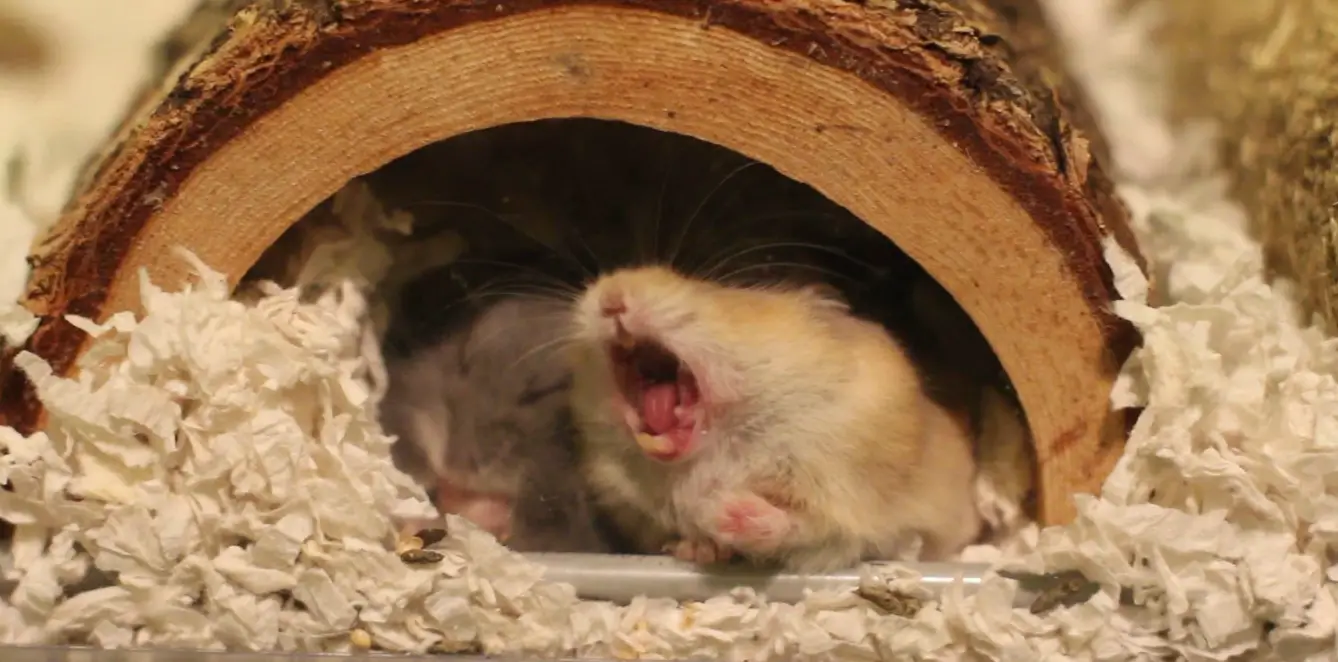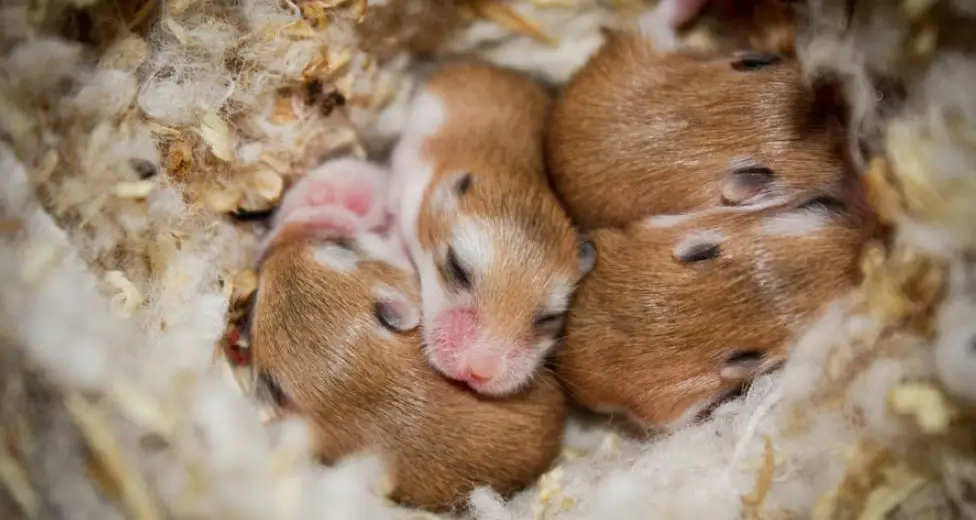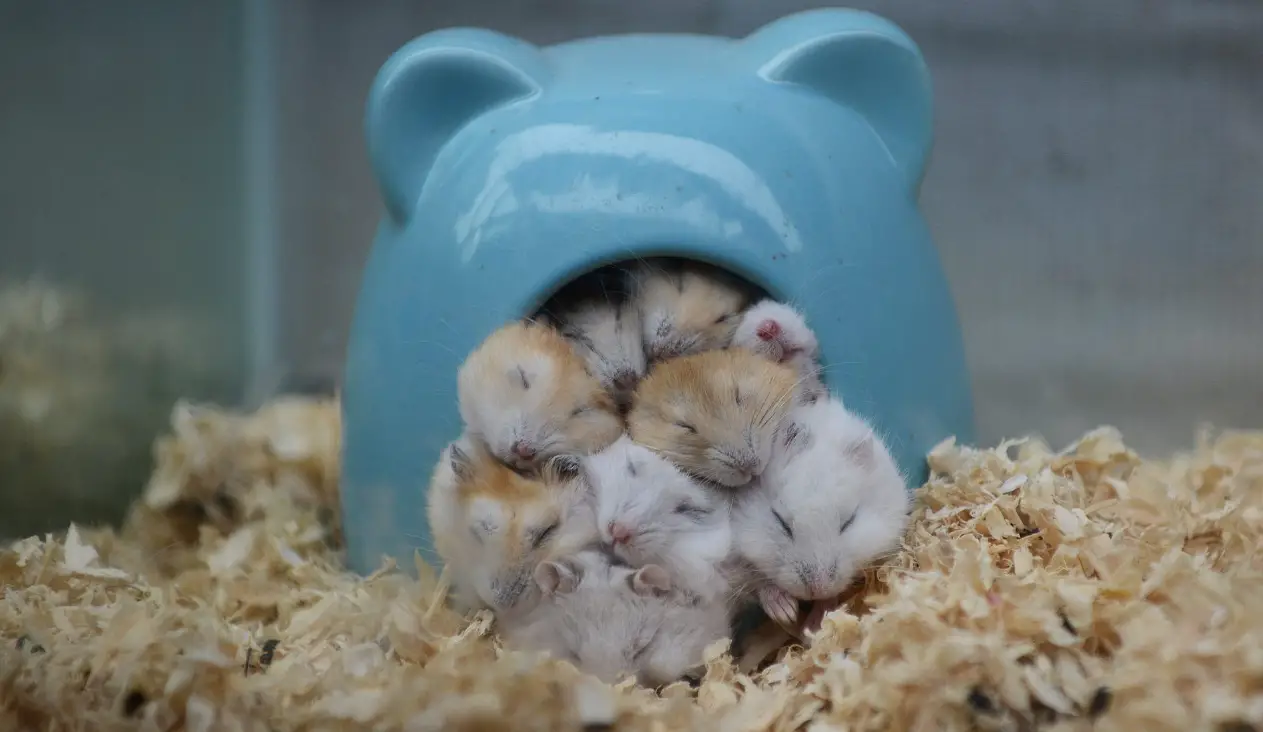- Pregnancy in hamsters
- How do hamsters reproduce in the wild?
- How do pet hamsters get pregnant?
- Hamsters sexual maturity
- How long are hamsters pregnant?
- How to know if your pet hamster is pregnant?
- How to care for a pregnant hamster?
- What to do after the female hamster gives birth?
- Why do some female hamsters eat their babies?
- When to separate baby hamsters?
- Final Thoughts
- FAQ
- How to care for motherless hamster pups?
- How often should female hamsters be bred?
- Can two pregnant hamsters live together?
- Should I leave the male in the cage or remove him when the female hamster is pregnant?
- Interbreeding hamsters
- Do pregnant hamsters smell?
- Can you handle hamsters when pregnant?
- Can You be around hamsters while pregnant?
- Can you clean a hamster’s cage while pregnant?
Pregnancy in hamsters
Pregnant hamsters must be kept alone in a large, clean, secure enclosure away from noise and sudden temperature changes, they also require nesting material, a high protein, fat, and carbohydrate diet, and above all, day-to-day supervision to prevent any health problems before they get serious enough to cause a pregnancy to be interrupted.
So here’s everything you need to know about how to properly care for a pregnant and nursing female hamster, and how to help her safely get through these two potentially life-threatening periods.

How do hamsters reproduce in the wild?
In her natural environment, the female hamster usually spends less than two hours a day outside her burrow, but during the mating period, she attracts the male via a ‘trail’ of vaginal marks.
For some dwarf hamster species, the female may also visit several males and mate with them during the night of the last day of her oestrus cycle.
The male hamster will be excluded from the burrow as soon as the coupling is over, and mating often takes place during the ideal season, when climate and food availability allows it.
In the wild, some dwarf hamsters, notably winter white hamsters, may permanently share some separate burrows, which makes mating more frequent, especially during periods of food abundance. Males may also help females to feed and rear the litter after birth.
How do pet hamsters get pregnant?
In captivity, hamsters usually don’t have a mating season because the temperature and food abundance conditions are always present in their enclosure, so the female hamster has a new estrous cycle every 4 days and can get pregnant at any period of the year.
But mating only leads to pregnancy if it occurs in the final 12 hours of the fourth day of the oestrus cycle, during the ovulation period.
How do hamsters mate?
The female hamster will be sexually receptive during the evening of the first day, initially showing aggression towards the male over the first two days, and rejecting all his attempts to mate with her.
Starting on the third day of the estrus cycle, the female hamster will start leaving scent trails due to her vaginal discharges, which will encourage the male hamster to approach her and even share the female’s nest box, waiting for her to become receptive again the next day.
During this last period of the oestrus cycle, the female will finally stop running away from the male and mating will begin over a period of almost 60 minutes in several repetitive sessions of just a few seconds each.
After mating, the female will usually turn aggressive towards the male, ejecting him from her side of the enclosure and cornering him on the opposite side of the cage. She will also empty his food bowl, which is a sign that it’s time to remove him from the enclosure and leave the female alone to prepare for her gestation period.
The end of the first oestrus cycle will be characterized by the appearance of a tenacious and opaque postovulatory discharge.
In the absence of a male, a female hamster will therefore have 7 estrous cycles every month.
How to trigger mating behavior in hamsters?
Before encouraging your hamster to mate, be sure that she’s not sick and her enclosure is ready for what’s coming.
Dwarf hamsters are easier to breed than Syrian hamsters, but almost all hamsters are also easier to breed if they come from the same litter or when introduced at a young age.
What triggers the mating behavior in wild hamsters is the arrival of rising temperatures, longer days, and abundant food and nesting material.
In captivity, these conditions are often present in most hamster enclosures, so they become a year around polyestrous and are always ready to mate, especially during spring and summer.
To encourage a female hamster to switch from hoarding behavior to mating behavior, all you need to do is make sure she has plenty of food and nesting material, the temperature exceeds 22°C and she’s exposed to at least 12 consecutive hours of daylight and finally, that there’s at least one healthy male hamster in the enclosure.
What conditions may affect the mating behavior in hamsters?
During the 4 days of the oestrus cycle, the female hamster will either be much more interested in either eating and hoarding food or in mating.
Here are some possible conditions that may influence sexual motivation in female hamsters:
Cold temperatures, lack of food, lack of nesting material, short daylight and the presence of other females, and even the absence of the exercise wheel can put the female hamster in survival mode and thus decrease her willingness to mate.
Temperatures above 22°C, more than 11 hours of daylight, abundant nesting material and food, large food stashes, a spacious enclosure, and a calm environment can encourage the female hamster to mate.
Hamster life cycle
Hamsters don’t live long, which is why they quickly become sexually mature. Females have several oestrus cycles per month and a shorter gestation period, around 16 days in the Syrian hamsters and less than 22 days in the Dwarf species.
Hamsters sexual maturity
Female hamsters reach maturity before males. They reach adulthood after just 5 to 6 weeks, and are able to breed starting from 6 to 7 weeks of age, whereas male hamsters reach adulthood at 6 to 8 weeks, but only become truly fertile at 12 weeks of age.
How long are hamsters pregnant?
The gestation period for Syrian hamsters lasts between 15 and 18 days, whereas the Dwarf hamster’s pregnancies tend to last longer, 20 to 22 days.
What’s the average litter size of a hamster?
Usually, female hamsters give birth to a litter of 2 to 16 pups, weighing between 2 and 4 grams each, but if the female is purebred, large enough, disease-free and lives in a large enclosure and in good conditions, she can easily give birth to more than 10 pups; we’ve already seen female hamsters with almost 20 pups in a single litter.

How to know if your pet hamster is pregnant?
When it comes to hamsters, it’s not easy to make a pregnancy diagnosis and fetal age estimation, especially during the first 10 days, unless the vet performs an Ultrasonography (real-time ultrasound pregnancy diagnosis).
But if you pay attention, you’ll notice that the pregnant hamster will become a little slower, a little lethargic, and will spend a lot of time napping and sleeping in her nest.
Pregnant hamster signs and behavior
The best way to tell if your female hamster is pregnant is by observing her postovulatory vaginal discharge on days 5 and day 9 following mating day. If she’s very aggressive towards the male and there’s no discharge on and after the fifth day, that means your female hamster is probably pregnant, and if it’s the same on day 9, you can be sure that your female hamster will soon be having pups.
Do pregnant hamsters become aggressive?
When a female hamster is pregnant, she will usually, during the first few days, appear restless, agitated, irritable, and more aggressive than before.
She will then start eating and hoarding more food than usual, with a preference for more nutritious, protein-rich foods. Finally, her abdomen (over the hips) will swell over the days and her usually tiny nipples will become more noticeable.
A few days before giving birth, she will show an unusual nesting behavior and starts piling up bedding and nesting material and creating her nest and finally, giving birth is often preceded by some vaginal Bleeding.
Pseudopregnancy in hamsters
Female hamsters can have a kind of “phantom pregnancy” lasting up to 10 days, this pseudopregnancy is often caused by an infertile mating (sterile mating), or an unsuccessful mating, and often occurs when there are other competing females in the same enclosure.
How to care for a pregnant hamster?
As soon as your hamster gets pregnant, you’ll need to make a few improvements to her enclosure to avoid the risk of accidents on the one hand and to provide her with the extra care she’ll need during this period of pregnancy and nursing on the other.
Preparing the enclosure for your pregnant hamster
When your hamster is in its first days of pregnancy, it’s a good idea to clean and sanitize the enclosure to avoid disturbing her and her pups later (until the pups are weaned), to ensure that the babies are born in a clean and healthy environment.
IMPORTANT TIP: Do not remove her food stashes, just make sure she hasn’t stored any rotten food and if her food stash is out of date, you’ll replace it with the same amount of dry food.
You can also set up a nesting box in the dark corner away from her food bowl, wheel, and water bottle, but away from her pee spots and sandbath as well.
remove access to upper floors and remove or secure elements from which your pregnant hamster could fall and lose its pups.
Also consider relocating the cage if it’s exposed to heat, draughts, cold, noise, or sunlight.
Do you remove the wheel for a pregnant hamster?
Can a pregnant hamster run on a wheel? It’s safest to remove the wheel in the last days of the pregnancy for at least 4 weeks, and then create a small obstacle between the wheel and the nest that will prevent the babies from accessing the wheel until they are at least 4 weeks old, firstly to avoid them getting stuck under the wheel and secondly to avoid them using the wheel, which could adversely affect their development or cause back and paw problems.
It’s also a good idea to place a generous amount of soft bedding around the wheel to cushion the impact in case your pregnant hamster falls while using it.
It’s best to remove the exercise wheel 2 days before delivery, and only put it back on 3 to 4 days after the babies are born. This is especially true for the dwarf hamsters, who sometimes seem to prefer to create their nest in the wheel.
Special bedding for a pregnant hamster
Baby hamsters will be born furless, so their mom will have to make sure they’re nestled in soft, clean, heat-conserving materials.
After you finish cleaning the enclosure, make sure you line it with a good layer of paper-based and Aspen bedding, and add some soft and clean hay, She’ll also need soft, safe if ingested, easily wearable, and extra absorbent bedding material for the nest, like soft unscented shredded paper towels or toilet paper,, pieces of natural tissue cut into ribbons.
Avoid cotton in your hamster’s enclosure, as it can cause blockage if swallowed.
Your pregnant female hamster will use these materials and some of her own fur to create a soft, warm nest to properly welcome her pups.
Special diet for a pregnant hamster
Hamsters eat regularly at 2-hour intervals, but during pregnancy and nursing, your hamster will increase food intake and hoarding to compensate for the loss of an average of 50% of her body fat.
During these two periods of pregnancy and nursing, the female hamster will need a quick supply of energy, which she will find in carbohydrate-rich, high-fat and high-protein foods.
If you’re feeding her a commercial diet, make sure her food contains at least 25% to 40% protein, along with 7% to 9% FAT, 5% to 10% fiber, and 35-40% carbohydrates for extra energy.
Otherwise, in addition to her usual diet, your pregnant hamster should have extra portions of these foods:
- Low-salt Cottage or Mozzarella Cheese
- Plain-cooked turkey or chicken breast.
- Boiled eggs
- Dried mealworms, small grasshoppers or crickets
- Soya
- Flaxseed
- Barley
- Peas Oats
- Sesame seeds
- Sunflower seeds
- Nuts
- Some baby food from time to time
- Fruit (double the usual portions)
Finally, your pregnant hamster will need easy access to fresh water, you can add another water bottle in case one stops working, as well as daily portions of fresh vegetables (1 tablespoon on average).
What to do after the female hamster gives birth?

First of all, you need to know that the female hamster can give birth to her young without you noticing and that they also often mate during the night of the day they give birth if the male is still there.
You should never touch the pups with your bare hands, especially in the first few days, so that the female doesn’t reject them, and then you’ll find yourself with one or more baby hamsters to feed, keep warm, and clean.
Why do some female hamsters eat their babies?
The female hamster may engage in cannibalism by eating one or more of her pups, especially during the first week after birth. The main reason is when her own survival instinct is triggered, here are the common causes:
- The female hamster is either hybrid or inexperienced (it’s her first litter).
- The female hamster is disturbed or stressed by other cage mates or by her owner or another pet (a predator).
- If she finds another unusual smell on her pups
- If food runs out in the enclosure or she is fed a poor diet.
- If the nest is too exposed and she runs out of nesting material.
- If the temperature suddenly drops below 5°C and can’t keep her pups warm anymore.
- In case of big litter size, she may eat a few pups to give the others a better chance of survival by getting rid of the weakest and sickest individuals.
- Finally, the female hamster may eat her pups in the event of accidental death, just to prevent them from rotting and causing the death of the other pups.
When to separate baby hamsters?
In hamsters, weaning occurs after 3-4 weeks (hamster pups should weigh at least 40 gr in Syrian hamsters and over), so it’s advisable to let their mother look after them not only during this lactation period but until they are introduced by their mother to their new diet, one or two weeks after the weaning, let’s say after they are at least 6 weeks old.
Just make sure there’s enough space for the mother and her pups but above all enough food for the whole family.
Final Thoughts
Caring for a pregnant hamster takes a little bit of extra knowledge, which you absolutely must acquire before thinking about breeding your female hamster.
Breeding hamsters shouldn’t be done just to impress your friends on Insta or create more content about them for Tiktok. Breeding should be left to ethical breeders who know how to select the healthiest individuals to help the species evolve.
You should never breed hamsters just because you want to have “some cute little baby hamsters” or for profit, as you’ll spend more money breeding them than you’ll make in selling them.
Finally, before breeding your hamsters, you need to check their lineage (family tree), their genetic condition, and their overall health to avoid poor genetics and ensure optimal conditions for them, for the pups that will be born and to help the female hamster regain her strength from the birth of the pups.
FAQ
How to care for motherless hamster pups?
Hamster pups are born blind, deaf, and furless, and if their mother unfortunately dies, you’ll have to syringe-feed them milk once an hour, for at least 7 days, also making sure their nest is clean and at a stable temperature to prevent them from getting cold and falling ill or dying. Hamsters drink milk exclusively for the first 21 days of their lives, after which you can feed them the usual hamster diet.
How often should female hamsters be bred?
Hamsters have very short lifespans, and their health is very delicate. The first thing to do is to wait until the female reaches fertile age, and then only breed less than three times to avoid the risk of disease and even death, sometimes during or after the fourth litter.
Can two pregnant hamsters live together?
No, two pregnant or nursing hamsters should never be kept in the same enclosure, not only because of their territorial behavior, but above all because of their strong maternal instinct, which will make them very aggressive towards each other and their pups.
In such cases, the pregnant female hamster will perceive the other as a direct competitor for her and her pups’ survival, since she will be sharing space, food, and other vital elements of the enclosure with her.
Should I leave the male in the cage or remove him when the female hamster is pregnant?
Usually, as soon as mating is over, the male hamster should be removed from the cage, as the female will become very aggressive towards him again, corner him and not even let him feed.
In the wild, especially dwarf hamsters (desert hamsters), when food is scarce, it has been observed that the male hamster often helps the female hamster to care for the pups, sharing his food supply with her and even looking after the litter if the female leaves the burrow on her daily rounds.
Interbreeding hamsters
Improper breeding is strongly forbidden in hamsters, especially if you don’t know the genetic history of the individuals, not only because only Campbell’s and winter white hamsters can interbreed, but also to avoid having hybrid pups with a shorter-than-average life expectancy, predisposed to many hereditary diseases such as diabetes and neurological problems, as well as aggressiveness and malformations.
Improper breeding can also result in hamsters whose lives will not be easy, as in the case where two white belly genes are bred. This is highly inadvisable as it can lead to the birth of Anophthalmic hamsters (eyeless white).
Hairless hamsters should also never be bred, as taking care of them is particularly difficult as they’ll be living without fur to protect them from their environment and its aggressions, and above all to force them to live without their whiskers, which the hamster uses a lot in its everyday life.
Do pregnant hamsters smell?
No, in fact when the female hamster becomes pregnant, it’s vaginal markings will stop and she’ll become increasingly clean in preparation for the birth of her pups.
The smell is probably not coming from your hamster but from her enclosure. If she’s in her first few days of pregnancy, you can do a quick cage cleaning and change her bedding. If not, just add her fresh bedding and do spot cleaning until the pups are weaned.
There are a few reasons why some hamsters smell and pregnancy is not really one of them.
Can you handle hamsters when pregnant?
Yes, but only during the first week of pregnancy, and you must be seated when handling your hamster. Handling a pregnant hamster must be done delicately and without putting pressure on the belly, so as not to harm the pups and force the hamster to terminate her pregnancy, and never stress a pregnant or nursing female hamster.
Can You be around hamsters while pregnant?
When a female hamster is pregnant or nursing, it’s best not to disturb her. Keep your interaction with your female hamster to a minimum:
- Give her food and water
- Add nesting material (2 to 3 days before delivery)
- Spot-cleaning when she sleeps
- Any treatment (if prescribed by the vet)
Can you clean a hamster’s cage while pregnant?
No, it’s best to do a thorough cleaning of your hamster’s enclosure before the pregnancy, but you can do a little cleaning without putting her under too much stress only during the first few days of her pregnancy to avoid her miscarrying and interfering with her pregnancy.
Some resources
Lousiana Veterinary Medical Association


